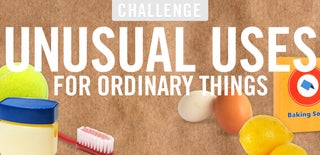Introduction: How to EASILY Anodize Titanium at Home (2 Methods)
Titanium anodizing is an extremely cool and rewarding project that is very easy to do at home. Anodizing is used industrially for enhanced corrosion resistance on metals like aluminum. Anodizing is also used as a decorative process for titanium jewelry as a wide range of colors can be achieved.
If you liked this instructable please vote for me. I would really appreciate it :D
Step 1: Learning the Science Behind Anodizing
Please note that the science behind anodizing can be complicated and hard to understand. Please skip to the next step if you want to jump right into anodizing. I would be more then happy to answer any questions through a PM or the comments below.
There is great website I found that explains how anodizing works better than me. The link is http://mrtitanium.com/interference.html
Step 2: Method 1 - Using a Chemical Cell - Intro
The first method of titanium anodization is done using a chemical cell. The titanium piece is is made the positive anode (hence the name anodization) and submerged into an electrolyte bath (borax and sulfuric acid are commonly used).
Step 3: Method 1 - Using a Chemical Cell - Step 1
Gather Parts and Tools
You Will Need:
1. Aluminum foil
2. A plastic container big enough to fully contain the piece you want to anodize
3. 1-8 nine volt batteries
4. At least 4 feet of insulated wire
5. Borax
6. Hot water
7. A spoon
8. Rubber gloves
9. Acetone or alcohol (the alcohol swabs at CVS work well)
10. A plastic cup (should hold about the same volume as your plastic container)
Tools (optional):
1. Pliers
2. Wire strippers
Step 4: Method 1 - Using a Chemical Cell - Step 2
Time to mix your electrolyte and build the anodizing bath.
Take the cup, spoon, borax and hot water and combine in the cup. Mix until all borax is dissolved. The closer the mixture is to saturation the better.
For the anodizing bath, take the aluminum foil and completely line the container with the foil. If there is any excess foil around the top of the container, I recommend folding it around the edge of the container.
Step 5: Method 1 - Using a Chemical Cell - Step 3
Time for the wiring and battery setup.
Strip about half inch of insulation off both ends of 2 foot wire lengths. After the wires have been stripped, Take one corner of of the aluminum foil and make a hole through it. Insert the end of the wire and twist them together. Tuck in the wire and aluminum corner. Now fill with the borax and water solution.
Take the desired number of nine volt batteries and connect them as shown in the picture. Then connect the wire that is attached to the foil to the negative (-) terminal of the battery. Take the other wire and connect to the positive (+) terminal of the battery (this is the wire that gets attached to the titanium piece).
Step 6: Method 1 - Using a Chemical Cell - Step 4
Time to figure out what color to anodize. Different voltages will produce different colors. Note that you can always change the color buy increasing the voltage but can not revert back to lower voltage colors. The above image is for anodizing in sulfuric acid but the results are pretty similar with borax. Remember, if you are unsure of the voltage needed, just go up in small increments of voltage.
Step 7: Method 1 - Using a Chemical Cell - Step 5
Cleaning the titanium.
Put on your rubber gloves to prevent any fingerprints on the titanium after it is cleaned. Then wipe down the titanium piece with the alcohol until is it very clean.
Step 8: Method 1 - Using a Chemical Cell - Step 6
Now for the actual anodizing.
Take the titanium and positive wire and touch them together. Submerge the titanium piece. Make sure that the the wire isn't submerged and only titanium touches the solution. Also, take caution and make sure the titanium never touches the foil at any time. It can short everything out and generate huge and dangerous sparks. Once the desired color is reached, take the titanium out and dry it. You will find that some colors are affected by fingerprints and can become dull when exposed to fingerprints. This is perfectly normal and the original color can be restored using acetone or alcohol to remove the oils
Step 9: Method 2 - Using Heat - Intro
For this anodization method, intense heat is used to thicken the oxide layer. I use a gas stove to anodize but a blowtorch is recommended.
Step 10: Method 2 - Using Heat - Step 1
Gather your parts and tools.
You will need:
1. A heat source (blowtorches are best but a gas stove works too)
2. A pair of tongs or needle nose pliers (the handles will get hot so make sure they are rubber coated to provide adequate insulation)
3. Alcohol or acetone (alcohol pads from CVS work well)
4. A cup of very cold water
Step 11: Method 2 - Using Heat - Step 2
Clean the titanium as in step 5 of the chemical cell method.
Step 12: Method 2 - Using Heat - Step 3
Time to anodize!
Take the cleaned titanium and grip the edge of it with tongs/pliers. Turn on your stove/blowtorch and bring the titanium piece close to the heat. Keep the titanium moving and you should notice a color change to yellow after about 30 seconds or so. Heat the titanium piece for longer to achieve reds, blues and some greens.
Step 13: Method 2 - Using Heat - Step 4
After the desired color is achieved, turn off the stove/blowtorch and submerge the titanium in the cold water to cool it down. Be careful not to touch the titanium until it is cool as it will burn you. Same goes for the tip of the pliers/tongs too.
Step 14: Conclusion
Congrats you have anodized titanium!! I hope you found this interesting as well as fun and enjoyable. Please share your thoughts in the comments below. I look forward to any comments or suggestions.
Step 15: Troubleshooting
If anodizing the titanium isn't working for any reason, please ask me in the comments as I would be more than happy to take questions!
Here are some possible solutions to problems you may encounter:
1. Make sure the titanium is the only thing submerged in the solution. The wire touching the titanium must not be submerged.
2. Make sure the wire touching the titanium is connected to the positive terminal of the battery.
3. Make sure you are using borax. Sulfuric acid works well too but is very dangerous to work with.
4. Make sure your batteries aren't dead.

Participated in the
Unusual Uses Challenge

Participated in the
Before and After Contest

Participated in the
Rainbow Contest











